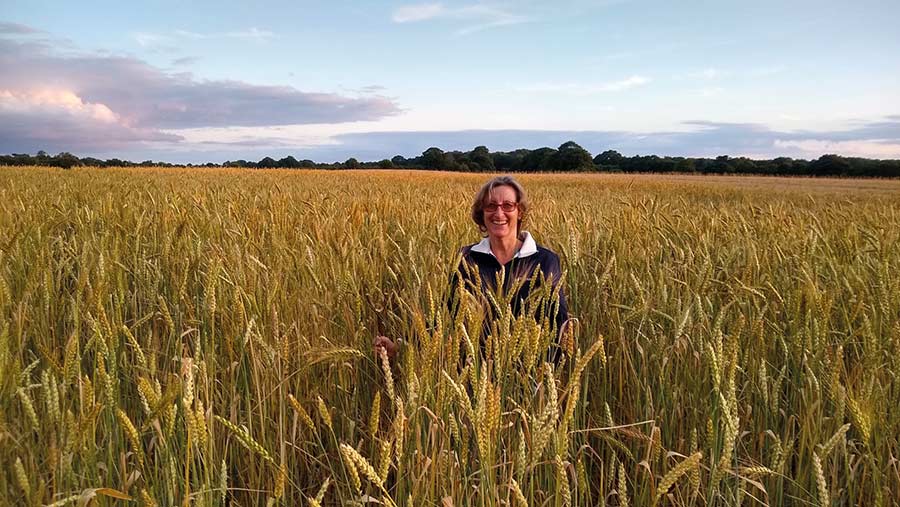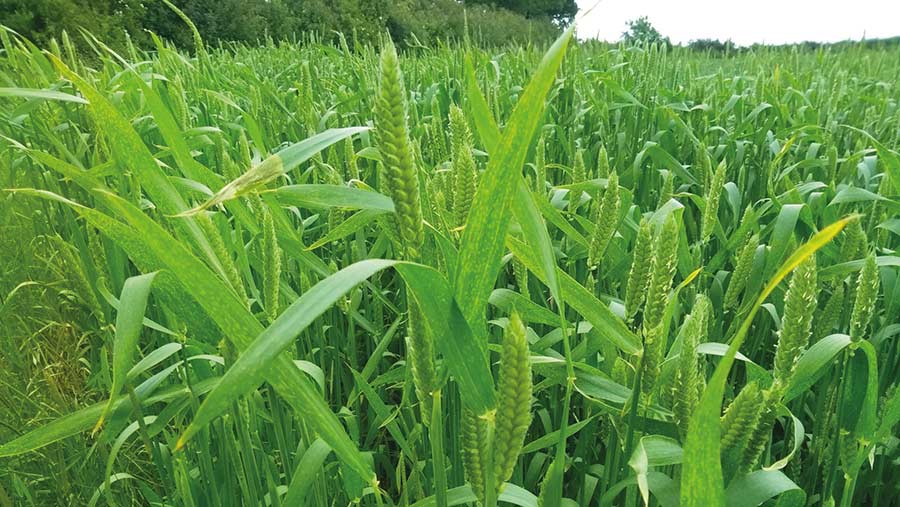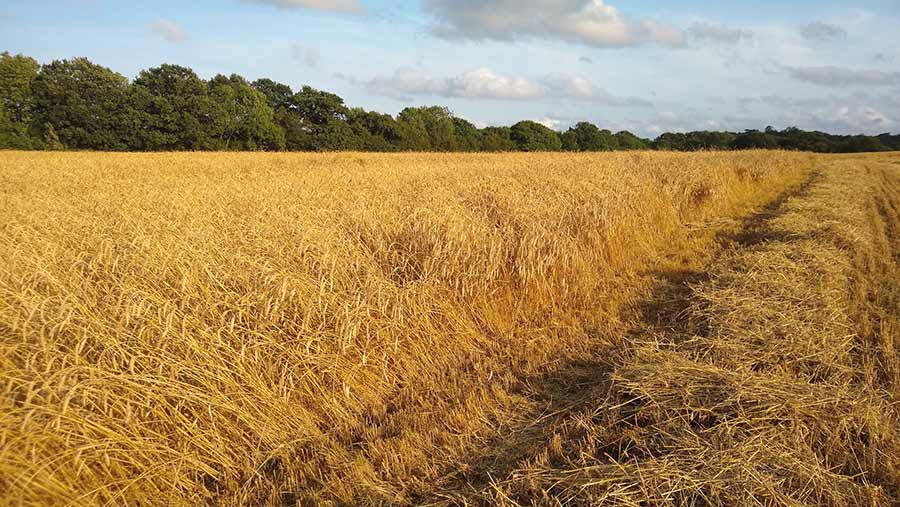Why heritage wheat forms heart of Surrey mixed farm
 Jenny Pinard © Mike Pinard
Jenny Pinard © Mike Pinard Growing and milling heritage wheat for the artisan bread market forms the heart of Mike and Jenny Pinard’s mixed arable and sheep farm in Surrey.
Varieties grown include England’s oldest recorded wheat, Red Lammas, which dates back to 1650. This reaches heights of 1.5m and forms some of the foundations of modern hard red wheat breeds today.
See also: How to calculate nitrogen use efficiency on-farm
Notable varieties: Heritage wheats and some more recent key UK arrivals
- 1650 – Britain’s oldest recorded wheat variety Red Lammas was widely grown
- 1953 – French-bred Cappelle Desprez was introduced and dominated farms for many years
- 1972 – Maris Huntsman was introduced, raising yields by almost 15% over rivals
- 1978 – Hobbit was the first true semi-dwarf
- 1980s – Avalon dominated milling wheats
- 2020 – Wolverine – the first variety with barley yellow dwarf virus resistance joins the AHDB Recommended List
After successfully trialing heritage cultivars back in 2016, the pair steadily increased the area grown and have since developed a thriving niche business, selling flour to a range of bakers and online.
This season, 100% of arable crops at Lodge Farm are heritage wheat. Although these wheats are lower yielding (about 2.5t/ha), Mr Pinard notes their exceptional tolerance to pests, weeds and disease.
This allows the couple to run a low-input, regenerative system. No fungicide or insecticides are used, with up to 20kg N/ha applied to crops at their 120ha National Trust farm, where they have enthusiastic support from their local trust agent.
How it started
It was rising production costs, limited margins on conventional varieties, a passion to grow more traditional crops suited to local soil type and the development of a minor gluten intolerance that spurred Mr Pinard into growing older wheat populations.
“Our conventional varieties would hardly yield [7.5t/ha] across the farm’s Weald clay soils, leaving limited margin. This just wasn’t worth growing,” he says.
He subsequently got in contact with Andy Forbes of Brockwell Bake who coincidentally was looking for a grower close to London to scale up his heritage wheat trial plots, based in allotments in the capital.
What started out with 30 different varieties grown at Lodge Farm and harvested in 2017, has been whittled down to just three: Red Lammas, Old Kent Red, and Chidham Red.
“Taste and flavour of the bread was the number one trait when it came to variety selection,” explains Mr Pinard.
“Unlike modern varieties, heritage wheats have different taste traits – particularly depending on soil type.”
He believes that mainstream wheat crops have a lot to learn from heritage wheat.
“People regard grain as a uniform commodity – it is sold as tonnes and not flavours. Take coffee, tea or wine – all taste so different and consumers buy depending on their flavour. Given the opportunity, grains have the potential for this.”
Variety choice
The fact that each of the selected varieties grown feature the word “red” is no coincidence as these cultivars were traditionally the harder, group 4 bread-making wheats which take their name from the array of red and orange shades of their straw and grain.
Red Lammas as the oldest known variety, was widely grown in Europe and the colonies. It has a characteristic reddish brown colour when in ear, with medium-sized hard red grains. The other varieties grown are local variants of Red Lammas.
“What was a truly amazing moment was realising that when we combined some varieties it was potentially the first time ever the variety had been harvested with a combine,” reports Mr Pinard.
Harvesting such a tall crop was initially challenging. Mr Pinard used lifters to help feed the crop into the machine, but found this tangled the crop further.
He then welded a tubular steel rod at a 45 degree downwards angle on to the header, which pushed the crop down. This enabled the crop to feed easily into the machine and resulted in a combining speed equally as fast as the harvest of a conventional cereal crop.

© Mike Pinard
Establishment
A mix of both the plough and direct drill is used to establish wheat at Lodge Farm. Six years ago, Mike Pinard designed his own no-till drill which plants wheat straight into a cover crop mix of mustard, vetch, millet and buckwheat.
To reduce risk of pest and weed build-up which arose from solely direct drilling, he ploughs every three to four years.
Crops are sown at a seed rate of 110kg/ha and receive up to 20kg N/ha, one-tenth of that applied to modern wheat.
Greater tolerance
Heritage varieties are well known for their greater tolerance to a range of pests, weeds and disease.
In fact, septoria has not yet posed an issue, says Mr Pinard. The crop’s greater height means the distance between each leaf is larger, eliminating risk of inoculum transfer via rain splash.
Consequently, no fungicides are applied to these traditional cultivars, where anywhere between two to four sprays were previously sprayed on conventional wheats at the farm.
However, three years ago an influx of yellow rust hit crops, prompting a one-off fungicide spray on a particularly bad patch, leaving the rest of the infected field un-sprayed.
Both the sprayed and un-sprayed areas shortly became disease free. Mr Pinard suspects the entire field would have been fine without chemical intervention as heritage wheats have greater energy reserves in their root and stem, compared with conventional varieties which help them fight against disease.
Similarly, older wheat populations show extreme competitiveness against weeds and when it comes to blackgrass, they compete reasonably well.
“Initially, we find heritage wheat slow to get going, making it vulnerable to blackgrass attack. Once it kicks-off, it races through it’s growth stages and outcompetes the weed. Blackgrass shifts its energy to grow taller to compete with the heritage wheat by reducing its numbers of tillers.”

© Mike Pinard
Milling and baking
Post-harvest grain is rested in bins for about four months, before being milled into flour and sold to a range of local bakers as well as online under the Heritage Wheat brand name.
Grain was previously milled at local windmill, Oldlands near Hassocks, but rising demand and the reliance on wind to power the mill, prompted the couple to purchase their own stone mill and bagging station.
“All flour is milled to order, ensuring fresh flour every time. We mill anywhere between 1-300kg of grain per week – all done in house,” says Mrs Pinard.
“There’s nothing like the satisfaction of a customer ringing to say how happy they are with a locally grown product that people love,” adds Mr Pinard.
Grain is also sold in bulk to other mills, and there is an exciting opportunity to supply flour for use in a major supermarket loaf next year. Unable to supply this alone they have formed a group of like-minded regenerative farmers to fulfil the contract.
What is heritage wheat?
Mike Pinard defines heritage wheat as a long-straw wheat grown as a diverse genetic population, growing to heights of 1.2-1.5m tall.
- Heritage wheats have one-quarter of the ears at harvest compared with conventional wheats
- Grain is tougher and harder than conventional
- Greater tolerance to weeds, pests and disease
- Significantly deeper rooting with more traits similar to that of wild plants
- Crops can bank energy and nutrient reserves to use during times of stress
- Up to 15 to 20 tillers per plant. If tillers or grain become damaged the plant aborts these, resulting in a more uniform grain sample.

